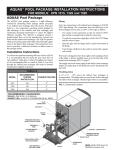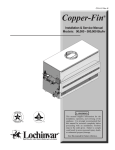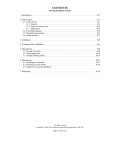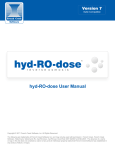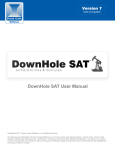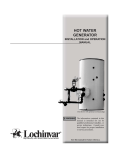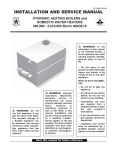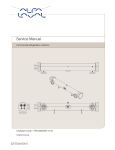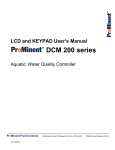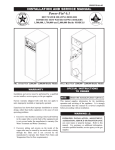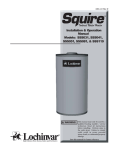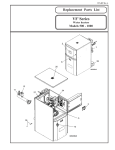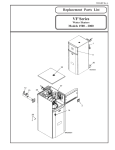Download INS70057 REV C:INS7207 Rev-.qxd.qxd
Transcript
INS70057 Rev C XLP POOL PACKAGE INSTALLATION INSTRUCTIONS FOR MODELS: XPN 399 – 800 XLP Pool Package The XLP pool package system is a high efficiency commercial condensing boiler, pre-piped package system from the factory to an indirect heat exchanger. This pool heater is a low temperature operating system designed to take advantage of the stainless steel heat exchanger and condensing operating temperatures to ensure the highest efficiency possible. The XLP is designed around a predetermined flow set by the manufacturer between the boiler and the indirect heat exchanger. The XLP operates off the pool system pump itself which will continually supply water to the indirect heat exchanger. This means there is no need to purchase a dedicated circulator to deliver water to this package system. Installation Instructions To achieve the optimum operating efficiency of your XLP it is recommended that you keep the pool water flow of each appliance within plus or minus five gallons per minute of the recommended flow as stated in Table A. Low flow through the indirect heat exchanger will result in elevated temperatures supplied to the pool. Piping Pool / spa connections to the indirect heat exchanger are SCH 80 CPVC. Pool water is designed to flow from right to left standing in front of the boiler (factory installed sensor is on the inlet side of the indirect heat exchanger, see FIG. 8). The supply and return water piping to the indirect heat exchanger shall be no smaller than 2.5" for models 399 - 600 and 3" for models 700 - 800. Throttling Valve A ΔT of 8° - 10°F across the indirect heat exchanger is recommended. Throttling valves are used to set the flow through the indirect heat exchanger (standard gate valves are acceptable). TABLE A MODEL RECOMMENDED SYSTEM WATER FLOW CONNECTION SIZE 399 93 GPM 2.5" 500 117 GPM 2.5" 600 142 GPM 2.5" 700 166 GPM 3" 800 202 GPM 3" FIG. 1_Component Location Air Inlet Connection RECOMMENDED CLEARANCES: BOILER - SEE KNIGHT XL BOILER I & O MANUAL INDIRECT HEX -- ALLOW 18” FOR SERVICE ON ALL SIDES Gas Inlet Flue Connection Pressure Reducing Valve / Auto Fill Valve System Sensor Location Cupro-Nickel Pool Heat Exchanger Skid Mounted on Steel Frame Condensate Drain Relief Valve T&P Gauge Flow Switch Boiler Pump 399,000 to 800,000 BTUs Expansion Tank The system can be installed in either a Full Flow or Diverted Flow orientation: Full Flow (reference FIG. 6) If the total system flow of the swimming pool or spa system is within five gallons per minute of the recommended system water flow as shown in Table A on page 1, this type of system is recommended. Diverted Flow (reference FIG.’s 7 & 8) Criteria for installing a diverted flow system is as follows: • If the total system flow is greater than the amount required by the indirect heat exchanger. • Installations with temperatures in excess of 95°F. This is necessary so the pool high limit will not trip. No water should enter the pool / spa in excess of 110°F. If the heat exchanger pool outlet is in excess of 110°F the water must be tempered down. • Multiple unit installation. Example: Total system flow is 500 gallons per minute (GPM). If two XLP Pool Packages (800,000 Btu/hr) were installed, each of the pool packages would require 202 GPM for a total of 404 GPM of the pool water being diverted through the indirect heat exchangers while the other 96 GPM would be diverted back to the pool. The limit will be mounted in a 3/8" NPT tapped fitting installed in the filtration system piping or it may be installed directly into a tapped opening in the PVC filter system piping. Turn off the filter system pump when installing the auxiliary limit in the filtration system piping. Tapped openings can be added to the PVC pipe by first drilling 9/16" pilot holes in the PVC pipe at least three feet downstream of the point where the heated water from the indirect heat exchanger is added to the filter piping. The drilled pilot holes can now be carefully threaded with a 3/8" NPT tap. After the pipe threads have been cut into the PVC pipe wall the limit and bulbwell can be inserted into the tapped openings. Apply a small amount of a high quality RTV silicone sealant to the threads to prevent leaks and install the limit and bulbwell into the threaded opening in the pipe. Install the limit control and bulbwell and tighten to seal. Do not over tighten either part into the threaded opening in the PVC pipe. Over tightening can damage the parts and/or strip the threads cut into the plastic pipe. Wire the 110°F limit into the pool heater control circuit as shown in FIG. 2. If additional wire length is needed, use 18 gauge wire for distances up to 30 feet. For longer distances, size the wire per Table B. TABLE B Remote Wire Connection Auxiliary Mixed Water Limit Control Ensure that the auxiliary 110°F mixed water limit control is installed in the filter system piping. Install the auxiliary limit a minimum of three feet downstream from the point where the heated water from the indirect heat exchanger is added to the filtration system (see FIG.’s 6-8). If the water leaving the heat exchanger is in excess of 110°F a bypass must be installed to temper the water below 110°F before re-entering the pool/spa. WIRE GAUGE MAXIMUM ALLOWABLE LENGTH 12 GA 100 ft. 14 GA 75 ft. 16 GA 50 ft. 18 GA 30 ft. FIG. 2_Low Voltage Connections AUX. DEVICE RELAY AUX. DEVICE 24VAC PILOT SUPPLY GND AUX. DEVICE PROVING 110° HIGH LIMIT SENOR GAS PRESSURE SWITCH FLOW SWITCH ALARM CONTACTS NO DHW THERMOSTAT R ROOM THERMOSTAT / W ZONE CONTROL LOW WATER CUTOFF FLOW SWITCH CN4 RUNTIME CONTACTS COM CN5 CN2 SYSTEM SENSOR DHW TANK SENSOR TO REMOTE ENABLE (JUMPER REQUIRED IF NOT USED) OUTDOOR SENSOR SHIELD GROUND A SEQUENCING B SHIELD GROUND 0-10VDC GND SYSTEM SUPPLY SENSOR CN3 EXTERNAL CONTROL CN1 (AUX) DHW SENSOR BUILDING MANAGEMENT SYSTEM LOW WATER CUTOFF SHIELD SHIELD FROM PREVIOUS BOILER INS70057 Rev C A B A B 2 TO NEXT BOILER Indirect Heat Exchanger Installation Instructions Heat exchangers should be installed downstream of the pumping and filtration equipment (reference FIG. 3). FIG. 3_Pumping and Filtration Equipment TO POOL CHLORINATOR (DOWNSTREAM) TOP VIEW FROM POOL SYSTEM PUMP FILTRATION Filling the System Pool Water Chemistry It is essential that the instructions in this section along with the Ryznar Stability Index and/or Calcium Stability Index are followed to prevent corrosion / erosion of the indirect heat exchanger: - - - - - - The boiler is filled through the pressure reducing auto-fill valve. The operating pressure of this system is 15 psi between the heater and the indirect heat exchanger. There are no adjustments necessary to the fill valve cartridge (factory set). The expansion tank is set at 20 psi. It is necessary to check the pressure of the expansion tank when annual maintenance is performed. The boiler system operates off a city or potable water system which feeds a closed loop system. A hard line is piped from the potable water supply to the pressure reducing valve. This water is to remain on at all times when the system is in operation. Always keep pH to within correct levels. The ideal pool pH should be kept to within 7.4 to 7.6. Under no circumstances should the pH fall below 7.2 or rise above 7.8 (see FIG. 4). Check on a day-to-day basis. Alter pool condition as necessary. Ensure that chlorine levels are within the range recommended by the chemical manufacturer and are in accordance with the type of pool, for example; private, hotel, school or municipal. If a bypass is fitted to the indirect heat exchanger circuit, it is essential that any or all of the valves are correctly positioned to allow the recommended pool water flow to pass through the heat exchanger. The system filter unit should be checked regularly, especially sand filters (to detect sand and diatomaceous earth). Sand filters, if working incorrectly, can allow sand to pass around the pool circuit causing erosion of the pipework and heat exchanger. Keep the pool free from debris such as leaves, grass cuttings, etc. This foreign matter can cause decay and increase pH. It is essential that the correct amount of chlorine dosage is added to the pool. To allow proper dispersion of the dose in the pool water, distribute the chemicals to various areas of the pool. Do not dose in one area only, as this will create high acidic areas which can cause corrosion / erosion of the pool equipment. Chlorinator should be installed downstream of the XLP. Pressure Reducing Valve The valve is equipped with a fast-fill feature that can be used to override normal operation when filling and purging the system. To activate fast-fill, push and hold down the fast-fill knob on top of the cartridge as shown in FIG. 5. Relieve air from the system through operation of the pressure relief valve by pulling the lever on top of the valve, causing it to open. FIG. 5_Pressure Reducing Auto-Fill Valve PUSH CAP DOWN TO ACTIVATE FAST FILL FIG. 4_pH Scale 7.4 - 7.6 INS70057 Rev C 3 FIG. 6_Full Flow FROM POOL CPVC FACTORY POOL RETURN SENSOR LOCATION 110° LIMIT TO POOL NOTICE Please note that these illustrations are meant to show system piping concept only, the installer is responsible for all equipment and detailing required by local codes. FIG. 7_Bypass (if flow is greater than required by heat exchanger) FROM POOL CPVC FLOWMETER VALVE THROTTLING FACTORY POOL RETURN SENSOR LOCATION 110°F LIMIT TO POOL RECOMMENDED ISOLATION VALVE FLOWSWITCH TEMPERATURE AND PRESSURE GAUGE RELIEF VALVE NOTICE Adjust valves to provide suggested flow per Table A on page 1. NOTICE Please note that these illustrations are meant to show system piping concept only, the installer is responsible for all equipment and detailing required by local codes. NOTICE System flow should always remain higher than the required flow for the boiler(s) when the boiler(s) is in operation to prevent short cycling and high limit issues. INS70057 Rev C 4 FIG. 8_Bypass Multiple Units (if flow is greater than required by heat exchanger) TO POOL FROM POOL 110° F LIMIT VALVE THROTTLING (3X) FLOWMETER (3X) (OPTIONAL) CPVC PIPING RECOMMENDED ISOLATION VALVE FACTORY POOL RETURN SENSOR LOCATION NOTICE Please note that these illustrations are meant to show system piping concept only, the installer is responsible for all equipment and detailing required by local codes. NOTICE System flow should always remain higher than the required flow for the boiler(s) when the boiler(s) is in operation to prevent short cycling and high limit issues. INS70057 Rev C 5 Press the ENTER key to access these parameters. Use the UP arrow key to access parameter H2 SH Source. Press the ENTER key to access this parameter. Use the DOWN arrow key to select Cascade. Press the ENTER key to program this into the control. Press the UP arrow key to select the parameter H3 BLR Address. Press the ENTER key to access this parameter. Each unit in the Cascade system must be programmed with its own address. The boiler designated as the Leader will have an address of 0. The remaining boilers in the Cascade will be Members and have addresses from 1 - 7. Use the UP and DOWN arrow keys to select the appropriate address. Press the ENTER key to program this into the control. Press the MENU key twice to exit the control parameters. Repeat this procedure for all boilers in the Cascade, designating the Leader control and the Member controls. Cascade When multiple boilers are installed, they can be wired together in a cascade sequence. A maximum of eight boilers can be controlled from a single control. In this application one boiler would be designated as the Leader control and all others would be designated as Member controls. If the water temperature at the inlet side of the indirect heat exchanger sensor is less than the setpoint + the turn-off offset the off-on differential, then the control will initiate a call for heat on the Cascade (see the Knight XL Service Manual for an explanation of the offset and differential). The Leader will energize the lead boiler on the Cascade. For a new startup this will be the Leader boiler. The boiler will fire at its ignition speed and will then modulate its firing rate to maintain the setpoint. If the first boiler reaches 100% of its firing rate, the Leader will calculate at what point the second boiler could fire at 20% of its firing rate. At this point, the Leader will fire the second boiler on the Cascade. For a new startup, this would be the first Member boiler. The boiler will fire at its ignition speed and will then modulate its firing rate to maintain the setpoint. If the setpoint still cannot be met, the Leader will continue firing more Members until either the heat demand is met or all boilers on the Cascade are firing. As the heat demand decreases, the last boiler on will modulate down to 20% of its firing rate. Once the demand for that boiler is zero, it will shut down. As the heat demand decreases further, the second to last boiler will modulate down and shut off. This will continue until the demand is satisfied and all boilers are shut off. XLP Pool Setup To access the Installer setting press and hold the Menu/Exit key until it requires the installer’s code. Proceed and enter #5309 (reference Table C on page 7). NOTE: NA = No adjustment necessary. Standalone Operation B: Temperature Settings B1: Pool Setpoint (pool temperature) B2: SH Min Setpoint (pool temperature minimum) B3: Max Setpoint (factory set at 104°F) B4: SH Offset (2°F minimum) Number of degrees above the setpoint that the boiler will turn off. B5: SH Differential (4°F minimum) Number of degrees below the turn off temperature the boiler must see before the boiler will turn on. Wiring of the Cascade When wiring the boilers for Cascade operation, select one boiler as the Leader boiler. The remaining boilers will be designated as Members. See “Configuration of the Cascade” for a detailed explanation of this procedure. Communication between the Leader boiler and the Member boilers is accomplished by using shielded, 2-wire twisted pair communication cable. Connect one of the twisted pair wires to terminal A on each of the Low Voltage Connection boards (FIG. 2), and the other wire of the twisted pair to terminal B on each of the Low Voltage Connection Boards. Connect the shield wires to one of the shield ground terminals on the Low Voltage Connection Boards. If more than two boilers are on the Cascade, daisy chain the wiring from the Sequencing terminals on the second boiler to the Sequencing terminals on the third boiler, then from the third to the forth, and so on. The connections between boilers can be made in any order, regardless of the addresses of the boilers. Try to keep each cable as short as possible. Example: Setpoint 78°F Offset = 2 Boiler OFF at 80°F Differential = 4 Boiler ON at 76°F Cascade Multiple Units Together B: Temperature Settings B1: Pool Setpoint (pool temperature) B2: SH Min Setpoint (pool temperature minimum) B3: Max Setpoint (factory set at 104°F) H: Control Modes Cascade H1: SH CNT Sensor NA H2: Control Source (Cascade) H3: Cascade Addr (Leader 0) (Member 1,2,3, etc.,) H4: Max Cascade Setpoint H5: Cascade Offset (2°F minimum, this is the warmest the pool will ever be above temperature) H6: Cascade Differential (This parameter determines how much the temperature must go below the turn off temperature (setpoint + offset) before the Lead boiler turns on. Four degrees is the tightest this setting can be.) Configuration of the Cascade When installed in a Cascade system, the individual controls must be programmed for cascade operation. This is accomplished by accessing the control parameters. Input the Installer code as described in the XLP Pool Setup Section (this page). Once the control parameters have been accessed, use the DOWN arrow key to select the H Control Mode parameters (reference FIG. 9 on page 7). INS70057 Rev C Example: Setpoint 78°F Cascade Offset = 2 Boiler OFF at 80°F Cascade Differential = 4 Boiler ON at 76°F 6 Knight XL control module Use the control panel (FIG. 9) to set temperatures, operating conditions, and monitor boiler operation. FIG. 9_Control Panel • Press to turn boiler off or back on • Press to select a menu item • Press after parameter programming to store parameter data • Press to exit Service Mode • Hold 5 seconds to enter code Input Mode (Menu Mode) • Press to move up one level in Menu Mode or to exit Menu Mode SHUTDOWN ENTER / RESET DISPLAY SCREEN MENU / EXIT SERVICE BUTTON PC CONNECTION PORT UP DOWN PREVIOUS • Press to change boiler water temperature set point during normal operation • Press to change displayed data values in Menu Mode • Press to navigate through menu listing in Menu Mode NEXT • Press to toggle display during normal operation to show outlet and return temperatures, fan speed, and flame signal • Press to toggle between digits when entering access code or between hour, minutes, etc., when entering date and time TABLE C Access Menu Screens MENU DISPLAY SCREENS ENTER MENU CODE: 5309 Access Menu Temperature Settings >A General B Temp Settings Control Mode G Anti-Cycling >H Control Modes INS70057 Rev C 7 Revision Notes: Revision A (ECO C04507) initial release. Revision B (ECO C05358) reflects the addition of the XLP pool package description . Revision C reflects the addition of Recommended Clearances in FIG 1_Component Location. INS70057 Rev C 6/10 - Printed in U.S.A.








